Search the Special Collections and Archives Portal
Search Results

Charissa B. Fabian oral history interview: transcript
Date
Archival Collection
Description
Oral history interview with Charissa B. Fabian conducted by Kyle Gregory Baluyut on November 24, 2021 for Reflections: The Las Vegas Asian American and Pacific Islander Oral History Project. In this interview, Charissa B. Fabian discusses her upbringing in Angeles City, Pampanga, Philippines with her three siblings and memories shared with her grandparents and cousins. She talks about her nursing education from the University of the Philippines and her immigration via a recruitment agency to work in New York. Charissa Fabian reflects on her move to Las Vegas, Nevada with her husband in 1995, the growing Filipino population in the city, and her work as a nurse. She also shares her thoughts on the immigration process, the COVID-19 pandemic, and politics.
Text
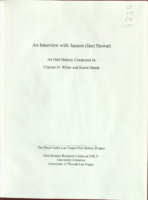
Transcript of interview with Jan Stewart by Claytee White, June 28, 2010
Date
Archival Collection
Description
In 1901, Jan Stewart's grandfather William T. Stewart brought his family to Alamo, Nevada in Lincoln County and about 90 miles north of Las Vegas to ranch. Soon he and his wife were operating a livery stable. One of his customers was an executive with the Union Pacific Railroad for whom he provided transportation to Las Vegas, where the railroad owned a ranch referred to as the Old Ranch. In this narrative Jan recounts how his grandfather and later his father became managers of the Old Ranch and lived a just a few dozen yards from the Old Mormon Fort, a historic Las Vegas landmark. In addition to sharing stories of his family's history, he describes how the ranch was a unique place to group up, brought the family in contact with many community people and an occasional celebrity.
Text
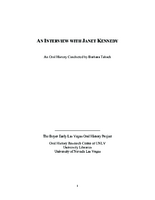
Transcript of interview with Jan Kennedy by Barbara Tabach, September 7, 2011
Date
Archival Collection
Description
Jan Kennedy was born (1924) Janet Parmelee, the daughter of a Connecticut physician and a homemaker. In high school she met Norman Kennedy, who she would marry after both had attended college and to whom she was married for 64 years. Until 1963, their roots seemed to be taking hold in the Seattle area. That is until Norm was offered an attractive career opportunity as a weather man at the Nevada Test Site. They settled in and enjoyed a zest-filled life with their four sons and a dynamic group of friends who they often entertained at their cabin in Mount Charleston. In addition, Jan managed to volunteer for a list of organizations including UMC Hospital/Southern Nevada Memorial Hospital; Clark County Museum Guild; Salvation Army Women's Auxiliary; church deacon; Assistance League; Red Hats—keeping herself ever busy and joyfully satisfied.
Text
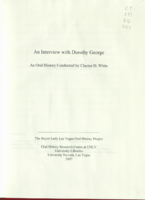
Transcript of interview with Dorothy George by Claytee White, October 13, 2003
Date
Archival Collection
Description
After serving as a nurse in World War II in Hawaii, Okinawa and Japan, Dorothy returned home to Chippewa Falls, Wisconsin. She experienced a particularly bad winter and she set out for California but stopped in Las Vegas to visit the family of her traveling companion, a girlfriend from her home town. The girlfriend returned to Wisconsin and George applied for a nursing license and got it within three days. She never left. Dorothy met her husband while working the night shift at Clark County Hospital. He would come in regularly to assist his patients in the births of their babies. Their occupations and their service in World War II drew them together in a marriage that has lasted over fifty years. From 1949 to this interview in 2003, Dorothy George has seen Las Vegas grow from a town that she loved to a metropolitan area that is no longer as friendly. She reminisces about the Heldorado parades, family picnics at Mount Charleston, watching the cloud formed by the atomic bomb tests, raising six successful children, leading a Girl Scout Troop, and working in organizations to improve the social and civic life of Las Vegas.
Text

Transcript of interview with Daniel Kaminski by Brian Corcoran, March 14, 1978
Date
Archival Collection
Description
On March 14, 1978, Brian Corcoran interviewed Twenty-One dealer Daniel Kaminski (born November 17th, 1947 in New Jersey) about his life in Southern Nevada. The two discuss Kaminski’s occupational history and gambling practices amongst tourists. They then go in depth on the rise of gambling establishments across the United States and the impacts it may have on Las Vegas. The interview concludes with a discussion on the role of dealers in casinos.
Text

Transcript of interview with Ray Christian by Russell L. Ellis, March 19, 1978
Date
Archival Collection
Description
On March 19, 1978, Russell L. Ellis interviewed former postal worker, Ray Christian (born 1927 in Las Vegas, Nevada). The two discuss Ray’s family history and his experiences as a Black man in early Las Vegas. Ray Christian compares the experiences of his childhood with that of his children in Las Vegas. The interview concludes with Christian expressing how Las Vegas has grown and that there are more opportunities available for his children to pursue.
Text
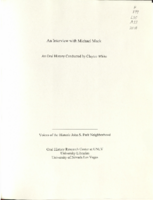
Transcript of interview with Michael S. Mack by Claytee White, May 21, 2009
Date
Archival Collection
Description
During this interview, Michael Mack visualizes his childhood memories of the later 1930s, when Las Vegas was a small, but steadily growing, desert town. As he says, "The desert was our backyard." The Strip hotels like the last Frontier and the Flamingo pop into the stories, but it was basically an innocent time. He attended John S. Park Elementary when classrooms were temporary buildings from the local Air Force base and the neighborhood was filled with children. He still maintains close friendships from that time. And he also recalls friends from the Westside neighborhood. Michael talks of scouting, riding horses, and watching Helldorado parades.
Michael Mack's first recollection of Las Vegas is as a two-year-old living in a duplex on Bonneville Ave. Though the family moved several times, they remained in or near the John S. Park neighborhood. Michael's father was a Polish immigrant who arrived in Boulder City, where he opened a shoe store, in 1932. The building of the Hoover Dam brought opportunities and his father Louis expanded into the salvage business. In time Louis moved the family to Las Vegas, opened a retail clothing store, which eventually sold uniforms, and set up the first local bail bondman office. During this interview, Michael visualizes his childhood memories of the later 1930s, when Las Vegas was a small, but steadily growing, desert town. As he says, "The desert was our backyard." The Strip hotels like the last Frontier and the Flamingo pop into the stories, but it was basically an innocent time. He attended John S. Park Elementary when classrooms were temporary buildings from the local Air Force base and the neighborhood was filled with children. He still maintains close friendships from that time. And he also recalls friends from the Westside neighborhood. Michael talks of scouting, riding horses, and watching Helldorado parades. Though the Macks were a Jewish family, Michael's mother always brought the Christmas tree to school. It was a period when people memorized each other's 3-digit phone numbers, went to movies for 14 cents, and there was a ranch for people to stay while getting divorced. Halloween Trick-or-treaters in the John S. Park neighborhood might get a tasty cupcake or a shiny dime. Michael has a plethora of stories about innocent mischief and the unique experiences of a boy growing up in Las Vegas.
Text

Transcript of interview with Eva Garcia Mendoza by Elsa Lopez and Barbara Tabach, September 25, 2018
Date
Archival Collection
Description
On the corner of 7th street and Clark, and beside the tennis courts of Las Vegas Academy, stands the law office of attorney Eva Garcia Mendoza. Eva has worked in her office since 1982, and in this time she has helped the Las Vegas community work through civil and immigration cases besides aiding in a myriad of other ways. Eva Garcia Mendoza was born in 1950, in the town of McAllen, TX-an environment that perpetuated hatred of Mexican Americans. Eva recalls the racism she endured; for instance, being spanked if she spoke Spanish in school, and her family facing job discrimination because of her skin color or her last name. Being an ethnic and financial minority was difficult, and Eva remembers nights as a child when she would cry herself to sleep. Eva showed resilience in the face of adversity as she states, “you rise to the level of your teachers’ expectations.” With the encouragement of her band professor, Dr. L.M Snavely, she began higher education at Pan American College. She moved to Las Vegas in 1971 and began to work before being accepted at UNLV to study Spanish literature. She graduated in the class of 1973. In 1975, Eva applied to become a court interpreter, a decision that would drastically change the trajectory of her career. She earned the coveted position and began to work beside Judge John Mendoza who was the first Latino elected to public office in the state of Nevada. Several years later John and Eva would wed. Judge Mendoza passed away in 2011. Eva talks about how extraordinary his legacy is-from his professional achievements to a story about his v football days and the 1944 Dream Team, this true story even piqued the interest of Hollywood writers. Through her work, Eva began to notice how she was more than qualified to become a lawyer herself, so she applied and gained a full ride scholarship to the Law School of San Diego University. Eva describes the struggles of attending school in San Diego while her spouse and children were home in Las Vegas. Despite the financial difficulties, being one of few minority students, and becoming pregnant her second year, Eva was able to finish her remaining university credits by returning to Las Vegas and working with Judge Mendoza. Together, they started the Latin Bar Association. Eva began her own practice in 1981 and would later partner with Luther Snavely, who was the son of her band teacher that helped her to attend college so many years back. Today, Eva has a new partner at her office and hired her son to work as a secretary. Eva also tells of the office’s mysterious history, of which includes a ghostly figure many clients claimed to have seen in the reception room. Eva recounts many of her professional achievements, such as petitioning to start the American Immigration Lawyers Association, Nevada Chapter, representing celebrities, winning the unwinnable cases such as against the Nevada Test Site. Eva talks about current events, such as today’s immigration laws, the discriminatory practices of revoking birth certificates from those born in Brownsville, TX., and about the importance of the #MeToo movement. Eva and her family have a great fondness for Las Vegas. The support for the Latinx community in Las Vegas greatly contrasts that which she experienced as a child in southern Texas. She describes wanting to take her children and grandchildren to visit her old home in McAllen, TX where her family grew up on the “wrong side of the tracks.”
Text

Transcript of interview with Rita Deanin Abbey by Claytee White, November 29, 2014 and February 26, 2015
Date
Archival Collection
Description
Rita Deanin Abbey is an Emeritus Professor of Art at the University of Nevada, Las Vegas. She taught drawing, painting, and color theory and innovated interdisciplinary courses with the sciences at UNLV from 1965 to 1987. The University of Nevada, Las Vegas, Marjorie Barrick Museum and the Palm Springs Desert Museum (presently Palm Springs Art Museum), Palm Springs, CA collaborated to present the Rita Deanin Abbey 35 Year Retrospective, which was held February 16-March 5,1988 at UNLV and March 25-June 5,1988 at the Palm Springs Art Museum. Abbey received her Bachelor of Fine Arts degree in 1952 and her Master of Arts degree in 1954 from the University of New Mexico, Albuquerque, NM. She also studied at Goddard College, Plainfield, VT; the Art Student s League, Woodstock, NY; the Fians Hofmann School of Fine Arts, Provincetown, MA; and the San Francisco Art Institute, San Francisco, CA. She was an artist in residence in the studios of Toshi Yoshida, Tokyo, Japan, John Killmaster, Boise, ID; Methow Iron Works, Twisp, WA; Tamarind Institute, University of New Mexico, Albuquerque, NM; the Mason Gross School of the Arts, Rutgers, The State University of New Jersey, New Brunswick, NJ; Shidoni Foundry, Tesuque, NM; Bill Weaver Studio, Chupadero, NM; Savoy Studios, Portland, OR; and Carlson & Co., San Fernando, CA. Abbey, who works in the areas of painting, drawing, printmaking, sculpture, porcelain enamel fired on steel, stained-glass, and computer art, has had 60 individual exhibitions and has participated in over 200 national and international group exhibitions. She is represented in private and public collections in the United States, the Middle East, Europe, and South America. Abbey has published several articles in journals, and six books: Rivertrip, Northland Press, Flagstaff, AZ, 1977; Art and Geology: Expressive Aspects of the Desert, Peregrine Smith Books, Layton, UT, 1986 (co-authored by G. William Fiero); the Rita Deanin Abbey Rio Grande Series, Gan Or, Las Vegas, NV, 1996; In Praise of Bristlecone Pines, The Artists' Press, Johannesburg (presently located in White River), South Africa, 2000; Isaiah Stained- Glass Windows, Gan Or, Las Vegas, NV, 2002; Seeds Yet Ever Secret, Poems and Images, Gan Or, Las Vegas, NV, 2013. She has been the recipient of many commissions and grants and has won several awards, including the Bicentennial Commission for the State of Nevada, 1976; the Governor's Seventh Annual Visual Arts Award for the State of Nevada, 1986; and the Chairman's Award of Excellence at the 1987 International Exhibition of Enamelling Art, Ueno Royal Museum, Tokyo, Japan. From 1988-1990, Abbey fabricated Northwind, a steel sculpture (17ft. x 27 ft. 5 in. x 25 ft. 10 in., 7 tons), installed in Las Vegas, NV. Abbey was invited by the Gallery Association of New York State to exhibit four of her works in its 1989-1991 traveling exhibition, Color and Image: Recent American Enamels. In 1992, the Markus Galleries, Las Vegas, NV, and the Nevada Symphony presented an exhibition of art by Abbey, which inspired Virko Baley s Piano Concerto No. 1. The world premiere performance of the concerto was held in 1993 at the National Opera House, Kiev, Ukraine. In 1993, Abbey constructed Spirit Tower, a cor-ten steel sculpture (20 ft., 11 tons), which was commissioned by the Las Vegas-Clark County Library District for the Summerlin Library and Performing Arts Center. Abbey was invited by the Pacific Division of the American Association for the Advancement of Science to lecture on Art and Geology at San Francisco State University for the 75th Annual Meeting, on June 19-24,1994. She was one of three artists from the United States invited to participate in the exhibition, Enamel Today, at Villa am Aabach, Uster, Switzerland, June-July, 1995. Additionally in 1995, Abbey completed a series of cast bronze sculptures at Shidoni Foundry, Tesuque, New Mexico. Commissioned in 1998, Abbey completed the Isaiah Stained-Glass Windows in 2000, sixteen 10 ft. x 2 ft. stained-glass windows for the main sanctuary of Temple Beth Sholom, Las Vegas, NV. Also in 2000, she completed Holocaust, a stainless steel sculpture (14 ft. 3 in., 4.5 tons), installed in Las Vegas, NV. In 2003 her bronze sculpture, Ner Tamid, was installed in Temple Adat Ami, Las Vegas, NV. Snakewash, a cor-ten steel ground sculpture (62 ft.), was completed in November 2003. Abbey fabricated steel sculptures and cast small and large bronzes from 2004 through the present. In 2006 she completed and installed Guardian of All Directions, a stainless steel sculpture (14 ft., 1.5 tons). The Guggenheim Hermitage Museum and Young Collectors Council visited the studio and home of Rita Deanin Abbey, Las Vegas, Nevada October 15, 2006. During March 2008, Women's History Month, Abbey was recognized for her contributions to the Arts by Mayor Goodman and Members of the Las Vegas City Council. Hidden Pass, a 2-inch steel plate sculpture (16 x 28 ft. 8 in. x 13 ft., 22 tons), was installed in 2010. Between July 16-December 23, 2011, Abbey exhibited in Blast from the Past, '60s & '70s Geometric Abstraction at Palm Springs Art Museum, Palm Springs, California. The City of Las Vegas Office of Cultural Affairs, Las Vegas Arts Commission presented Abbey the Lifetime Achievement Award for Excellence in the Arts on May 25, 2012. Balanced Arc, an outdoor bronze sculpture (8ft. 8 in. x 9 ft. x 7 ft. 4 in., 1600 lbs.), completed in 2012, was installed in April 2013. The Western Museums Association 2014 Annual Meeting in Las Vegas, NV, toured The Art of Rita Deanin Abbey at the Desert Space Museum October 5, 2014. Abbey participated in the fall group exhibition Macrocosm/Microcosm: Abstract Expressionism in the American Southwest at the Fred Jones Jr. Museum of Art, University of Oklahoma, Norman, Oklahoma, October 2, 2014-January 4, 2015. Her artwork was also shown in the Recent Acquisitions exhibition at the Marjorie Barrick Museum, University of Nevada, Las Vegas, June 19-September 19, 2015. Currently, Abbey is working on new sculptures, paintings, and enamels. vii
Text
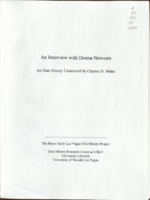
Transcript of interview with Donna Newsom by Claytee White, June 11, 2009
Date
Archival Collection
Description
Donna Newsom shares the history of her life in great detail, beginning with her childhood in Georgia and Florida. The family moved many times, following her father's work opportunities. Donna had a close relationship with her father and recalls the many daring adventures on which he took her. After graduating from high school, Donna earned a nursing degree at the Macon Hospital School of Nursing. She remembers dorm life, long hours, and the specific training nurses received in the late forties. Her career began at age 19 with a year of working at Macon Hospital as a graduate nurse, and then she made plans to leave the South. Donna's memories include moving to Houston, living in a boarding house, her first date, and working at Hermann Hospital and then Methodist Hospital. She then answered an ad to work at a Girl Scout camp in Colorado, and her roommate there became a mentor and one of her staunchest supporters. With help from her mentor, Donna went on to earn a teaching degree in Austin, Texas, met and married her husband Sam Newsom, and got involved in real estate. She relates the many experiences they had during Sam's Navy career, her teaching experience in New Orleans, and their eventual move to Las Vegas. Sam and Donna loved Las Vegas from the moment they moved here. She recalls many details of her employment at UMC, the differences in health care compared to down south, and the feeling of being safe no matter the time of day or night. Donna stays active in tutoring, the OLLI program at UNLV, and working for the Salvation Army women's auxiliary. She and Sam also get together with his golfing buddies and their wives for dinners in their various homes.
Text
